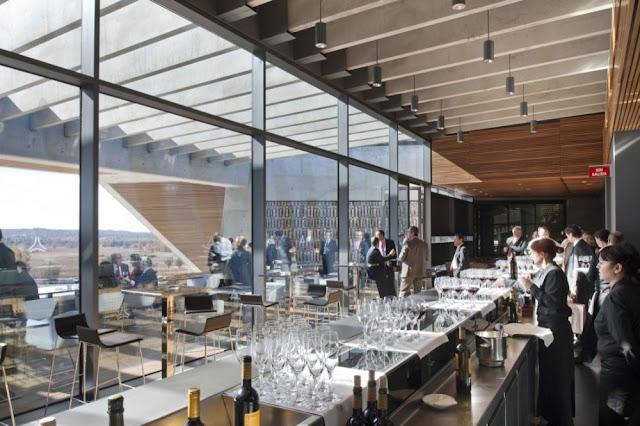Gumiel de Izan, Ribera del Duero, Spain
Foster + Partners
Post By:Kitticoon Poopong
 |
| Photo © Courtesy of Nigel Young / Foster + Partners |
The
Ribera del Duero region, one of Spain’s foremost
wine producing areas, is home to a new
winery for the
Faustino Group. The Faustino Winery is Foster + Partners first winery and was an opportunity to look afresh at the building type, using the natural topography of the site to aid the wine-making process and create the optimum
working conditions. The trefoil plan reflects the principal process stages, with the operational support and visitors
facilities strategically located in the center of the building. The public areas are on a
mezzanine level along with a restaurant with views of the surrounding landscape. Two volumes house the ageing processes and are strategically buried into the natural slope of the site taking advantage of the thermal cooling benefits of the earth.
 |
| Photo © Courtesy of Nigel Young / Foster + Partners |
 |
| Photo © Courtesy of Nigel Young / Foster + Partners |
“
Bodegas Portia is our first winery, so we had no preconceptions about how it should work. It was an opportunity to start from first principles – to examine the different stages of
wine production and to try to create the ideal conditions for them to unfold. The wine was the starting point, as well as the beautiful setting in Ribera del Duero. Using materials that draw on the region’s wine-making traditions, with public spaces open to the landscape, will enhance the visitor experience,”
stated Norman Foster.
 |
| Photo © Courtesy of Nigel Young / Foster + Partners |
 |
| Photo © Courtesy of Nigel Young / Foster + Partners |
The 12,500 square-metre facility has a production capacity of one million bottles per year. The building’s trefoil design expresses the three main stages of production: fermentation in steel vats; ageing in oak barrels; and finally, ageing in bottles. These are controlled by an operations hub at the core.
 |
| Photo © Courtesy of Nigel Young / Foster + Partners |
 |
| Photo © Courtesy of Nigel Young / Foster + Partners |
The wings containing the barrels and bottle cellar are partly embedded into the ground to produce the most favourable environmental conditions for ageing the wine, while the fermentation wing is exposed, allowing carbon dioxide to be released. A road rises to the roof of the building, where the harvested grapes are delivered straight into the hopper: the winery is designed to take advantage of the sloping terrain, using gravity to aid movement of the grapes within the building, maximising efficiency and minimising damage to the grapes. The concrete structure is clad in shingles of Corten steel.
 |
| Photo © Courtesy of Nigel Young / Foster + Partners |
 |
| Photo © Courtesy of Nigel Young / Foster + Partners |
The site in the Ribera del Duero, approximately 150 kilometres north of Madrid, has extremely cold winters, as well as hot summers with limited rainfall. The deep overhang of the roof canopy provides shade and the building is designed to regulate the internal temperatures, at the same time as reducing energy demand. By partly embedding the building within the landscape, its visual impact is minimised and the passive environmental benefits are maximised – the roof incorporates photovoltaic cells and the thermal mass of the concrete structure helps to control interior temperatures.
 |
| Photo © Courtesy of Nigel Young / Foster + Partners |
 |
| Photo © Courtesy of Nigel Young / Foster + Partners |
At the heart of the winery a raised public gallery extends into glazed mezzanine areas, which project deep into each wing, allowing visitors to enjoy elevated views of the different processes. Between the wings is a light-filled public reception and administration area, where extensive terraces and pools of water overlook the vineyards. Lined with deep-stained old wine barrel slats, the public areas are designed to evoke the rich tradition of wine-making in the region.
 |
| Photo © Courtesy of Nigel Young / Foster + Partners |
 |
| Photo © Courtesy of Nigel Young / Foster + Partners |
 |
| Photo © Courtesy of Nigel Young / Foster + Partners |
 |
| Photo © Courtesy of Nigel Young / Foster + Partners |
 |
| Photo © Courtesy of Nigel Young / Foster + Partners |
 |
| Photo © Courtesy of Nigel Young / Foster + Partners |
 |
| Photo © Courtesy of Nigel Young / Foster + Partners |
 |
| Photo © Courtesy of Nigel Young / Foster + Partners |
 |
| Photo © Courtesy of Nigel Young / Foster + Partners |
 |
| Photo © Courtesy of Nigel Young / Foster + Partners |
 |
| Photo © Courtesy of Nigel Young / Foster + Partners |
 |
| Photo © Courtesy of Nigel Young / Foster + Partners |
 |
| site plan--drawing Courtesy of Foster + Partners |
 |
| floor plan 01--drawing Courtesy of Foster + Partners |
 |
| floor plan 02--drawing Courtesy of Foster + Partners |
 |
| roof plan--drawing Courtesy of Foster + Partners |
 |
| section 01--drawing Courtesy of Foster + Partners |
 |
| section 02--drawing Courtesy of Foster + Partners |
The people
Architects: Foster + Partners
Location: Gumiel de Izan, Ribera del Duero, Spain
Design Team: Norman Foster, David Nelson, Gerard Evenden, Pedro Haberbosch, Nadine Pieper Bosch, Ana Agag Longo, Juan Gabriel La Malfa, Luca Latini, Chris Lepine, Emanuele Mattutini, Josep Mercader, Jaime Valle
Structural Engineer: Arup
Mechanical and Electrical Engineer: Arup
Quantity Surveyor: DLE
Lighting Consultant: Claude Engle
Project Manager: Prointec
Local Architect: Prointec
Main Contractor: FCC
Client: Bodegas Faustino SL
Project Area: 12,500 sqm
Project Year: 2010
Photographs: Nigel Young / Foster + Partners
via:archdaily




























